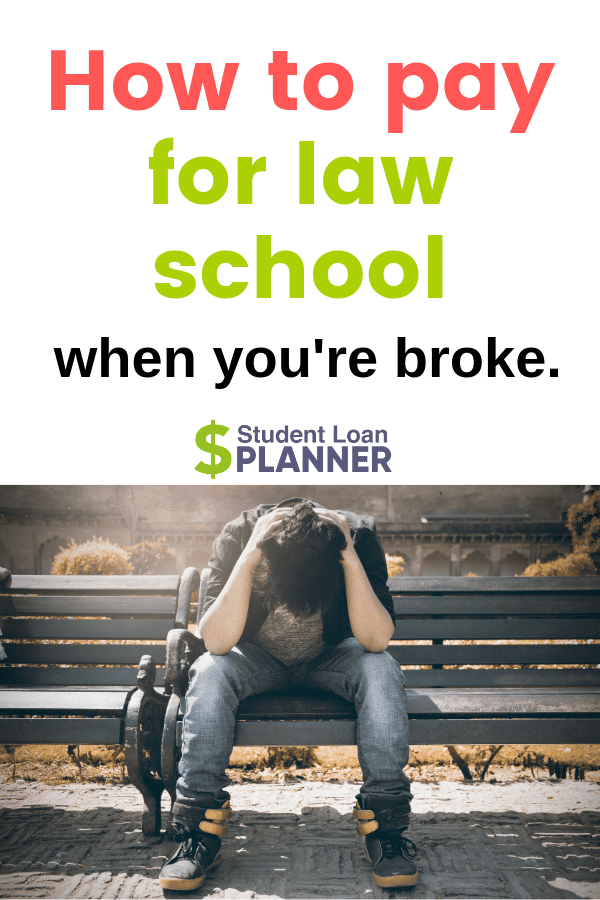The majority of people in law school take out student loans to pay for their cost of attendance, including tuition and other living expenses. It can be a good investment depending on how a lawyer will be able to pay back the loans. Read on to learn how to pay for law school and how different types of loans affect repayment.
Step 1: Law school financial aid, grants, scholarships and other tactics to reduce student loans
Take out as few law school loans as possible. Simple as that. The fewer loans you have to pay back, the better off you’ll be. If you demonstrate financial need, you may qualify for grants and scholarships first, lowering your out-of-pocket cost of law school. Then, take on federal loans next from the federal government (through the Department of Education), and only take on what you need.
If you get accepted to a top-20 law school, then it might be worth going at just about any cost. These top schools offer not only the highest starting salaries (often in the $150,000 to $180,000 range), but they also have some of the highest rates of employment (in the 80% to 90% range) after graduating with a law degree.
But if you’re going to a school outside of the top 20, then here's how to pay for law school, while keeping your loan balance low.
Pick a low-cost, in-state law school and avoid out-of-state and private law schools.
If I’m being honest, private law schools (outside of the top 20) can be a total rip-off. The law school cost is outrageous compared to the future prospects of a young attorney-to-be.
When I talk with other lawyers, they tell me it’s better to attend a more affordable law school. That's because competitive offers will come if students work their tails off and graduate near the top of the class. Go to an in-state public law school, study hard and get the degree.
Apply for scholarships and grants galore!
If you think about how much money a young lawyer will have to make to pay back their loans, you'll see that you'd be better off spending the time to get scholarships and other financial aid. Break that down to an hourly rate (scholarship dollars awarded per hour of work applying), and the hourly rate could rival a seasoned attorney.
Start with the Free Application for Federal Student Aid (FAFSA) to determine your eligibility for need-based aid, such as scholarships and grants. Then move on to your College Scholarship Service (CSS) Profile.
According to data from U.S. News, these 10 public colleges award the most aid for law school:
- Pennsylvania State University (Dickinson Law)
- Pennsylania State University (University Park)
- University of Minnesota
- University of Illinois (Urbana-Champaign)
- Indiana University, Bloomington (Maurer)
- Michigan State University
- University of Michigan (Ann Arbor)
- University of Oregon
- Texas A&M University
- University of Iowa
Here are the top 10 private universities with the most aid available for law school:
- St. John’s University
- Chapman University (Fowler)
- Washington University in St. Louis
- Yeshiva University (Cardozo)
- New England Law Boston
- Loyola Marymount University
- Case Western Reserve University
- Wkae Forst University
- Stanford University
- University of Miami
Source: U.S. News public and private school rankings
There are also plenty of private foundations and other organizations that offer scholarships. Search Google for merit and need-based law school scholarships like it’s your job!
Just be careful. Sometimes what looks like a scholarship or grant might actually end up being a loan. Do your homework before committing to anything on FAFSA.
Work part-time
I know you might not think it’s possible, and you should definitely put school first, but if you can make an extra $1,000 per month, not including your summer internship, that’s about $24,000 in loans you don’t have to take out. Some law schools do have restrictions around working during school, so check in with the school first.
Another option could be to save what you can over summer break going into law school or between each year of school (i.e., between 1L, 2L and 3L). You may also qualify for federal work-study programs as well that can help cover law school expenses.
Taking these steps will insure you can take out the most flexible and least expensive student loans.
Step 2: Federal Student Loans
Federal student loans have the most flexible repayment options and various loan forgiveness programs, so it’s a good place to start. You can also lower monthly payments through repayment programs such as income-driven repayment (IDR). This is a major perk for law school graduates who want to have more control over their student loan debt.
Here are the various types of federal student loans to go for.
Federal Direct Unsubsidized Loans
A law student can take out $20,500 per year. These are the easiest loans to get since there isn't a credit history requirement.
Plus, these loans also give you ultimate repayment flexibility, including income-driven repayment (IDR) plans like Pay As You Earn (PAYE), Revised Pay As You Earn (REPAYE), Income-Based Repayment (IBR) and Income-Contingent Repayment (ICR).
You’ll also have access to Public Service Loan Forgiveness (PSLF). The fees on these loans are relatively low at just over 1%.
Federal Direct PLUS Loans
These would be the next loans in line. A credit check is required, but as long as your credit isn’t totally trashed, you should be able to qualify. The fees are monstrous at over 4%.
However, these loans are still eligible for income-driven plans as well as PSLF, so they could still be a better option than turning to private lenders.
Avoid Parent PLUS Loans
Don’t let your parents take out a Parent PLUS Loan on your behalf. These loans are the least flexible of all federal loans.
Repayment is based on your parents' income, and loan forgiveness will take them 10 years on PSLF or 25 years on ICR, which is the worst income-driven plan.
It sounds good on paper to have parents help out with loans, but when it comes to loan repayment, they place a heavy burden on parents.
Step 3: Private loans for law school
Private student loans should be a last resort. Avoid them if at all possible.
Think of private loans like a mortgage. The payments are based on the loan balance and have to be paid back in full over the specified term.
The interest rates can be fairly high, and repayment is very inflexible. There’s no forgiveness or income-driven repayment and often no forbearance.
If you absolutely have no other choice, be sure to select a fixed-rate and prioritize paying these loans off in short order upon graduating, five to 10 years tops.
Explore these private student loan options for lawyers.
- Sallie Mae has a specific loan program tailored to law school students. With no origination fee, the market leader in student loans has a good shot at getting you the lowest interest rate.
- Earnest has a fast application and approval process that is popular with our readers.
We recommend shopping around with at least three lenders to find the best rate and terms and only take on a loan amount for what you need.
Law school loan repayment options
We’ve worked one-on-one with nearly 550 lawyers, totaling more than $124 million in student debt here at Student Loan Planner®. We’ve found there are really only two optimal ways to pay back law school loans.
Taxable loan forgiveness using an income-driven repayment plan for federal loans
For households that owe more than two times their income in student loans (e.g., lawyers who owe $200,000 and earn $100,000 or less), selecting an IDR plan like PAYE or REPAYE for 20 to 25 years could be the best option. In the end, the remaining loan balance is forgiven, though taxes will be owed on the forgiven amount.
The idea is to keep student loan payments as low as possible, save up for the tax bomb and work toward other financial goals along the way.
Aggressive repayment with refinancing to get a lower interest rate
For lawyers who owe 1.5 times their income in student loans or less (e.g., owe $225,000 or less and make $150,000 or more), their best bet could be to throw everything, including the kitchen sink, into paying off the debt as quickly as possible.
The goal is to pay as little interest as possible and to eliminate the debt in 10 years or less — hopefully much less. This may also include refinancing to get a lower interest rate. When you refinance, you could save money and pay less interest.
Be sure to consider any private loan payments and loan forgiveness options for the federal loans before committing to refinancing. Once loans are refinanced and removed from the federal program, the only option is to pay off the loans. Affording the payment is a must.
PSLF for lawyers
If you pursued a legal education to work in the public interest or work at law firms helping people, PSLF might be for you. Most lawyers take a significant pay cut to work for a nonprofit or government employer, hoping the PSLF benefit is better than making more income in the long run. This may or may not be the case, though.
The PSLF benefit has a number attached to it, so it’s important to compare the savings in student loan repayment with PSLF versus paying back the loan using another repayment strategy to see if the numbers support the thought.
That being said, career choice and fulfillment are very important. If a lawyer wants to work in the public sector or for a nonprofit, that’s awesome! PSLF would be a great side benefit. But if a lawyer chooses that line of work for 10 years just to get PSLF, run the numbers with our calculators first.

How to save the most money paying back law school loans
There’s a ton of money at stake when we’re talking about taking out and paying back six-figure student loan debt. It’s just like buying a house.
We kept hearing that our readers and clients wished they had known about all the student loan rules before they went to school in the first place. So we listened and created the pre-debt consult. This would be perfect before taking out law school loans and starting as a first-year student.
A Student Loan Planner® expert will review your specific situation and find the optimal strategy to take out law school loans.
If you already have law school loans, we’ve worked with many lawyers and would love to help you get on the right plan and feel confident about how you’re handling them to save as much money as possible with a student loan consult.
| Lender Name | Lender | Offer | Learn more |
|---|---|---|---|
| Sallie Mae |
Competitive interest rates.
|
Fixed 3.49 - 15.49% APR
Variable 4.54 - 14.71% APR
|
|
| Earnest |
Check eligibility in two minutes.
|
Fixed 3.47 - 16.49% APR
Variable 4.99 - 16.85% APR
|
|
| Ascent |
Large autopay discounts.
|
Fixed 3.39 - 15.71% APR
Variable 5.01 - 15.27% APR
|
|
| College Ave |
Flexible repayment options.
|
Fixed 3.47 - 17.99% APR (1)
Variable 4.44 - 17.99% APR (1)
|




